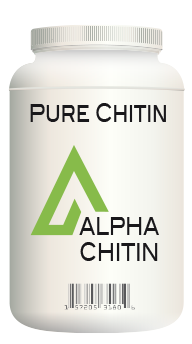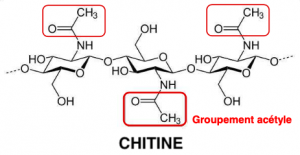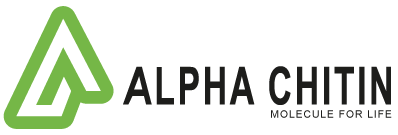Alpha-chitin can supply chitin to chitosans refiners or companies with their own functionalization process. It will necessarily be chitin from larvae or Krill in 20kg packaging. Molecular weight on request, guaranteed deacetylation rate <10%.

chitin
chitosans
We custom formulate and manufacture our chitosans based on our customers’ applications. We do not have a standard product catalog. We are available and eager to help you choose the best chitosan at the best price to meet your needs. Alpha-chitin can study and formulate simple functionalizations of chitosans.
HERMETIA
HERMETIA
Alpha Chitin is mastering management and growth of the BSF (Hermetia Illucens) larvae …
Alpha-Chitin offers complete and specific solutions for each of our clients.

DEFINITION OF CHITIN AND CHITOSANS
Chitin is the second most abundant biopolymer in nature after cellulose. Chitin does not have a single chemical structure but several, it encompasses several polysaccharides composed of N-acetyl-β-D-glucosamine units (from 50% to 100%) and D-glucosamine units (from 0 to 50%).
Chitin is present in crustacean co-products as a chitin-protein-mineral complex (mainly calcium carbonate), or as a mixture of polysaccharides in fungi
It is extracted in three steps:
• demineralization by acid hydrolysis, to remove minerals,
• deproteinization by basic hydrolysis, to eliminate proteins,
• whitening (or bleaching): optional step to remove pigments.
Between these different steps, washing operations are necessary.

The chitin can then be deacetylated to obtain the chitosan:
• chemically: at high temperature using a concentrated base (eg sodium hydroxide),
• enzymatically with chitin deacetylase.
The border between chitosan and chitin corresponds to a degree of deacetylation (DD) of 60-70%: below the compound is called chitin, beyond, chitosan.

Chitosan is soluble in acidic medium (at pH <6.5) unlike chitin which is insoluble.
A very large number of bioactive derivatives can be obtained from chitin and chitosan by various chemical or enzymatic reactions.
Chitin and chitosan are biocompatible, biodegradable and non-toxic allowing their use in fields ranging from agriculture to medicine.
Chitosan has the exceptional feature of being positively charged (in an acidic environment), which allows it to react with all negatively charged biological compounds (mucous membranes, bacteria walls, lipids, etc.) and to fix them firmly by ionic binding. This particularity gives it many properties (bio-adhesion, film-forming agent, etc.).
Since 2000, chitin and chitosan have been the subject of over 20,000 scientific publications and 50,000 patents! Their properties and applications are very varied and depend on their physicochemical characteristics.
Chitosans are characterized by:
• the raw material from which they are derived (insect, shrimp, squid, mushrooms, etc.)
• their molecular weight, their conformation and molecular chain length,
• their degree of deacetylation,
• their purity (technical grade, pure and ultra pure) which depends in particular on the quantities of ashes and remaining proteins, on the concentration of insoluble substances (turbidity), of certain heavy metals, and on the biological “load” (bacteria, yeasts, mold, …).
PROPERTIES OF CHITIN AND CHITOSANS
Chitosan is a non-porous material very stable in solid phase (dry) and an almost infinite conservation. In solution, it is more fragile and degradable.
It has a high degree of chemical reactivity due to its free primary amine group which gives it a high positive charge density. The presence of the amine function along the macromolecular chain makes it possible, compared to cellulose, to carry out chemical reactions specific to this function. Another property of chitosan and chitin relates to their ability to interact with other chemicals (ions, molecules, macromolecules) which allows them to have the ability to interact, complex or absorb.
Due to its chemical structure, chitosan constitutes a substitute for biological environments. Indeed, chitosan macromolecules are also present in the extracellular matrix of most living tissues.
These biopolymers have extraordinary biological properties that are both varied and complementary.
Chitin and chitosans are non-toxic, biodegradable and bioactive. Since chitosan is biocompatible, its presence within an organism prevents inflammatory reactions and induces very limited rejection reactions. It is bio-absorbable with low and controlled kinetics. It does not exhibit any anti-gene behaviour but has an anti-thrombogenic and haemostatic character. It inhibits the growth of many parasites and drastically reduces the development of infections.
In addition, it has remarkable anti-tumour and healing properties by increasing the healing rate of open wounds by stimulating the immune response and tissue reconstruction while preventing microbial infections.
APPLICATIONS OF CHITIN AND CHITOSANS
Alpha Chitin is developing a new French sector in order to produce chitin / chitosan using high-performance chemical processes (environmental and financial footprint), strategic products whose production in Europe is almost non-existent compared to world production. Currently chitin is extracted mainly from the shrimp shell, with industrial production mainly concentrated in Asia. With limited production and strong worldwide demand, chitin / chitosan is a product of the future in an existing and future market with multiple promising and constantly growing applications.
Chitin and especially chitosan find important applications in different fields due to their many and diverse properties.
BIOMEDICAL – PHARMACEUTICAL *
Acceleration of wound healing and healing – Treatment of epidermal lesions – Stimulation of tissue regeneration (cell proliferation) – Matrix for bone regeneration (bone substitute or cartilage) – Stimulation of the immune system – Artificial blood vessels – Dressings – Bio-absorbable surgical sutures threads – Anti-coagulant agent – Hemostatic agent – Bacteriostatic agent, spermicide – Anti-infectious, anti-bacterial, anti-fungal agent- Anti-tumor agent – Encapsulation of cells – Absorption of platelets (proteins) – Angiogenic therapy – Dialysis membrane – Control of release of active ingredients (drug drops) – Oral or local drug administration system – Adjuvant of vaccine – Excipients – Encapsulation, immobilization of enzymes – Dietetic products – Care creams, dermatological treatments – Contact lenses – Food supplements (slimming) – Decrease in cholesterol levels – Fat fixator – fight against excess weight – Dental gels – Dental implants.
COSMETIC*
Shampoos – Moisturizing agent – Anti-static agent – Thickening, stabilizing agent – Anti-allergic – Fungicidal and bactericidal agent – Release of ingredients, surfactant – Moisturizing, healing and anti-aging creams – Sun filters.
AGRI-FOOD *
Additives (binder, emulsifier, stabilizer, thickener, preservative) – Restructuring of vegetable, fruit and meat purees – Stabilization of color and aromas – Release of aromas or pigments – Clarification, deacidification and detoxification of drinks and liquids food – Anti-bacterial activity, food coating – Prevention of oxidation – Iron extraction (bad odors in meat) – Immobilization of enzymes or cells (cheese dairy, dietetics, aquaculture) – Dietetic food – Food protective films anti-bacterial, anti-fungal.
AGRICULTURE – WINE CULTURE AND PROCESSING *
Clarification, deacidification and stabilization of wines – Preventive or curative treatment of organic wines – Seed packaging (encapsulation) – Cell immobilization (horticulture) – Fungicide (bio-pesticide) – fertilizer – Crop protection – Control of metals essential for the growth of plants – Increase in yields – Animal feed – Performance nutrition – Animal vaccination.
ENVIRONMENT*
Drinking water treatment (coagulation / flocculation, filtration, absorption) – Wastewater treatment (coagulant) – Swimming pool water treatment (cation chelating agent) – Chelation of toxic metals and radioisotopes – Recovery of reusable metals – Sludge dewatering agent.
* Non-exhaustive list
